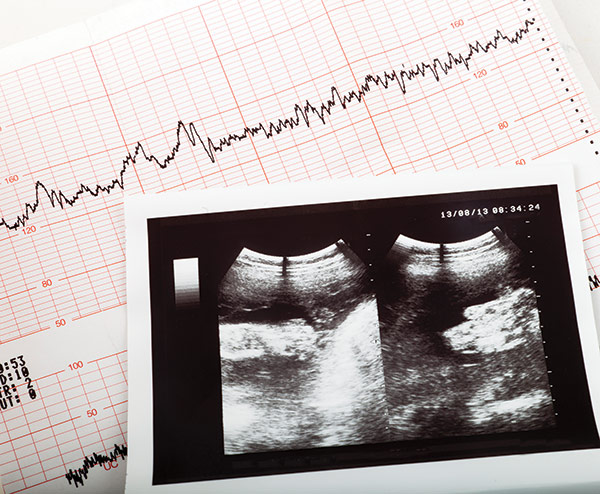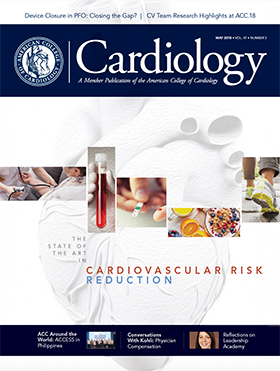Journal Wrap
The hottest research from various peer-reviewed journals — handpicked weekly by the ACC.org Editorial Board led by Kim Eagle, MD, MACC.
Weight Change During Childhood and Adolescence Affects Risk for Adult T2D

Being overweight at seven years of age is associated with increased risks of adult type 2 diabetes (T2D), but only if it continues until puberty or later ages, according to a study published in the New England Journal of Medicine.
Lise G. Bjerregaard, PhD, et al., examined data from the Copenhagen School Health Record Register. The database contains information (including mandatory medical exams) on most children who attended public or private schools in Copenhagen who were born between 1930 – 1989. In 1968, the database was linked to the Danish Conscription Database, which includes men born from 1939 – 1959 and includes information on height and weight during early adulthood. Height and weight were collected on participants at ages seven and 12 years and in early adulthood (17-26 years). Overweight was defined using Centers for Disease Control and Prevention criteria. Data on T2D status in 6,710 persons older than 30 years were obtained from the National Patient Register. Read More >>>
A total of 62,565 men were included, of whom 10.7 percent were diagnosed with T2D during 1,969,165 person-years of follow-up. The prevalence of overweight increased from 5.4 percent at seven years old to 5.5 percent at age 13, and to 8.2 percent in early adulthood. Overweight at any age was positively associated with the risk of T2D. These associations were stronger at older ages of overweight and at younger ages at diagnosis of T2D.
The risk of T2D being diagnosed between the ages of 30-60 years was similar in men who had remission of overweight before age 13 and men who had never been overweight (hazard ratio [HR], 0.96). Compared with men who had never been overweight, the risk of T2D was higher (HR, 1.47) in men who were overweight at seven and 13 years but not during early adulthood, but this risk was lower than in men with persistent overweight. The risk of T2D was fourfold higher (HR, 4.14) in men with persistent overweight vs. never overweight.
An increase in body mass index between age seven and early adulthood was associated with an increased risk of T2D, even among men whose weight had been normal at seven years of age.
These data strongly support the need to prevent childhood overweight early and before puberty to lower the risk for T2D in adulthood.
Bjerregaard LG, Jensen BW, Ängquist L, et al. N Engl J Med 2018;378:1302-12.
Stroke Alters Cognitive Trajectory
Incident stroke alters a patient’s cognitive trajectory and the effect is greater with increasing age and cardioembolic stroke, according to research published in Stroke.
Deborah A. Levine, MD, et al., examined 22,875 patients aged ≥45 years without baseline cognitive impairment from the REGARDS study who were enrolled from 2003 to 2007 and followed through September 2015. They measured the effect of incident stroke on changes in cognitive function and cognitive impairment using a Six-Item Screener (SIS) score of <5 and tested whether patient factors modified the effect. The median follow-up was 8.2 years. Patients with baseline moderate-to-severe cognitive impairment, including dementia, defined as an SIS score <5, were excluded. Read More >>>
Every six months, formally trained technicians administered cognitive function tests by telephone. The primary outcome was the SIS score. In addition, a battery of three cognitive tests were given, including the Consortium to Establish a Registry for Alzheimer’s Disease Word List Learning that measured new learning; Word List Delayed Recall that measured verbal memory; and Animal Fluency Test that measured executive function.
A total of 694 participants experienced incident stroke. Participants had a median of seven SIS tests and a median of two three-test batteries. A patient’s trajectory of global cognition and executive function was altered by stroke, and this effect was greater with increasing age. Compared with younger survivors, older survivors had significantly faster declines in global cognition and executive function after stroke.
Education was found to modify the effect of stroke on cognition. Compared with stroke survivors who were college graduates, stroke survivors who had less than a high school education had greater acute decline in executive function after stroke. However, education did not modify the effect of stroke on the slope of executive function. Changes in new learning and verbal memory after stroke did not vary by age and education.
The acute decline in global cognition after stroke was greater in black patients compared with white patients and greater in men compared with women. Declines in global cognition over the years after stroke were significantly faster in participants living outside the Stroke Belt compared with those who lived in the Stroke Belt. The change in the acute decline in global cognition after stroke did not differ by region. Changes in new learning, verbal memory and executive function after stroke did not vary significantly by race, sex and region.
Compared with hypertensive survivors, nonhypertensive survivors had significantly faster declines in executive function after stroke. Ischemic and hemorrhagic strokes were associated with acute declines in global cognition and faster declines over the years. Among ischemic strokes, cardioembolic and large vessel subtypes were associated with significant acute declines in global cognition. In the years after cardioembolic stroke, global cognition declined significantly faster than it did before the stroke.
The authors conclude that incident stroke alters a patient’s cognitive trajectory, and this effect is greater with increasing age and cardioembolic stroke. Race, sex, geography and hypertension status may modify the risk of post-stroke cognitive decline.
Levine DA, Wadley VG, Langa KM, et al. Stroke 2018;49:987-94.
Mothers of Babies with CHD May Have Future Heart Risks

Women who give birth to babies with congenital heart defects may be at a more than 25 percent greater risk of cardiovascular hospitalization later in life, according to a recent study published in Circulation.
Nathalie Auger, MD, MSc, et al., studied a cohort of 1,084,251 women who had delivered infants between 1989 and 2013 in Quebec, Canada, and identified women whose infants had critical, noncritical or no heart defects. The women were then tracked for up to 25 years for future hospitalization for cardiovascular disease. Read More >>>
A total of 1,516 infants born to these women had critical heart defects and 14,884 had noncritical heart defects. The incidence of cardiovascular hospitalization was higher for women whose infants had heart defects. There were 3.38 cardiovascular hospitalization per 1,000 person-years for critical defects, 3.19 for noncritical defects and 2.42 for no heart defects. Compared with those with no heart defects, women whose offspring had critical or noncritical heart defects tended to be hospitalized earlier for most cardiovascular diseases. For myocardial infarction, women whose infants had critical defects required a median of 7.2 years to attain five hospitalizations per 10,000, but this was 9.8 years for women with offspring without heart defects. Similarly, women whose infants had critical, noncritical or no congenital heart defects required a median 16.8, 15.2, and 22.0 years, respectively, to attain five cardiac arrests per 10,000.
The cumulative incidence of cardiovascular hospitalization began to diverge shortly after pregnancy for several outcomes. For women whose offspring had critical heart defects, the incidence of heart failure, myocardial infarction and coronary angioplasty increased more rapidly after 10 years of follow-up vs. women whose infants had no heart defects. The incidence of valve surgery accelerated after 18 years. With noncritical defects, the increase in cardiovascular hospitalizations was generally steady over time. The risk of maternal cardiovascular hospitalization also varied depending on the specific heart defect. Associations were stronger for critical defects such as hypoplastic left heart syndrome, but the majority of noncritical heart defects were associated with an elevated risk of cardiovascular hospitalization.
“[H]aving an infant with a congenital heart defect may represent a novel risk factor for developing cardiovascular disease,” the authors write. “Women who have a newborn with a heart defect may therefore benefit from early primary prevention and counseling to reduce their risk of cardiovascular disease.”
Auger N, Potter BJ, Bilodeau-Bertrand M, Paradis G. Circulation 2018;Apr 2:[Epub ahead of print].
CV Mortality Not Increased in Breast Cancer Patients
Heart-specific mortality among breast cancer survivors treated with radiotherapy or chemotherapy is not increased compared with the general population, according to a study published in the European Heart Journal.
While breast cancer survival has improved treatment-induced cardiotoxicity remains a major concern. Read More >>>
Janick Weberpals, PhD, et al., identified women diagnosed with breast cancer from 2000 – 2011 and treated with radiotherapy or chemotherapy using the Surveillance, Epidemiology, and End Results-18 (SEER-18) database and followed them until 2014. To investigate heart-specific mortality relative to the general population, long-term (≥10 years) standardized mortality ratios (SMRs) were calculated. Prognostic factors for heart-specific mortality were assessed by calculating cause-specific hazard ratios with corresponding 95 percent confidence intervals using the Cox proportional hazards regression. Subgroup analysis on intermediate-term mortality according to molecular subtypes, for which information was available since 2010, was performed.
A total of 347,476 breast cancer patients were included. Compared with patients who did not receive radiotherapy or chemotherapy, treated patients were more likely to die due to breast cancer (9.5 vs. 11.5 percent) and less likely to die due to a heart-specific disease (6.4 vs. 2.1 percent). Treated patients were more frequently diagnosed with a HER2-positive molecular subtype (16.4 vs. 9.6 percent), but less often diagnosed with estrogen receptor positive and progesterone receptor positive molecular subtypes (77.4 vs. 84.7 percent and 66.3 vs. 72.7 percent, respectively).
The highest cumulative mortality was caused by breast cancer, followed by noncancer causes unrelated to heart disease. Heart-specific cumulative mortality was marginally lower than cumulative mortality due to cancers other than breast cancer. Cumulative heart-specific mortality steadily increased with age at diagnosis and length of follow-up. In the oldest age group (≥75 years), cumulative mortality from heart-specific diseases exceeded cumulative mortality from breast cancer about 12 years after diagnosis.
Comparing heart-specific mortality in treated breast cancer patients with the general female U.S. population, SMRs tended to be slightly decreased for all age groups, with an overall decrease of 16 percent in the age-standardized analysis.
“[T]his study identified some potential prognostic factors for heart-specific and breast cancer-specific mortality, some of which were quite consistent with previously published literature,” the authors write. “More importantly, however, it was observed that the heart-specific mortality among breast cancer patients treated with radiotherapy or chemo-therapy is not increased and rather comparable with the general female population.”
They add that further studies with more detailed data on treatment are needed.
“This might add knowledge for further development of cardio-oncological risk stratification among breast cancer patients and help clinicians to make informed decisions about which patient strata are at highest risk and who would benefit most from preventive actions,” they conclude.
Weberpals J, Jansen L, Müller OJ, Brenner H. Eur Heart J 2018;Apr 9:[Epub ahead of print].
Keywords: ACC Publications, Cardiology Magazine, Angioplasty, Body Weight, Body Mass Index, Brain Ischemia, Breast, Breast Neoplasms, Cardiotoxicity, Cardiotoxins, Centers for Disease Control and Prevention, U.S., Cognition, Confidence Intervals, Dementia, Diabetes Mellitus, Type 2, Heart Arrest, Heart Defects, Congenital, Heart Diseases, Heart Failure, Hospitalization, Hypertension, Hypoplastic Left Heart Syndrome, Infant, Infant, Newborn, Myocardial Infarction, Overweight, Pediatric Obesity, Pregnancy, Primary Prevention, Receptors, Estrogen, Receptors, Progesterone, Risk, Risk Factors, Stroke, Survivors
< Back to Listings

